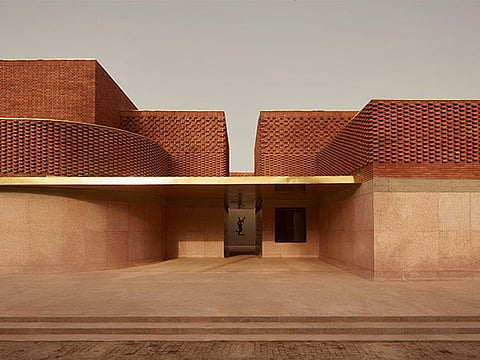Yves Saint Laurent designed by Studio KO
An architecture discovery of the YSL Marrakesh museum

Marrakesh, in Yves Saint Laurent Street, is located the famous Majorelle Garden. Just aside, the new Yves Saint Laurent Museum opened in 2017, the first one still in the historic ateliers in Paris, located at Avenue Marceau.
Designed by Studio KO, the agency founded by French architects Olivier Marty and Karl Fournier, the museum welcomes the work of the legendary French fashion designer. The permanent collection gathers a unique selection of clothing archives such as the iconic tuxedo, the Mondrian dress, and the Saharian, typical from the Rive Gauche collections. The collection from the museum is also completed by haute couture accessories, thousands of sketches, and assorted objects, in an original scenography designed by Christophe Martin.
The museum welcomes temporary exhibitions, an auditorium, a bookshop, a café-restaurant with a terrace. We can also visit the research library, housing thousands of books about Arabic and Andalusian history, geography, literature, and poetry, as well as numerous volumes related to botany, Berber culture, Yves Saint Laurent’s oeuvre, and the world of fashion. There are also private underground spaces to conserve the Haute Couture archives. In street view mode, the building looks minimalist and in harmony with urbanism.
The architects designed a composition of cubic forms adorned with bricks which create a pattern resembling threads of fabric. The giant YSL logo wall, which we can see from the street, invites us to the circular patio creating a relation between the sun, the sky, and the ground. The inside is markedly different, like the lining of a luxurious couture jacket: luminous, velvety, and smooth, protected from the sunlight and the heat.
Inside the hall, we discover the patio entirely covered with emerald brick and embellished with a fountain. Built of terracotta, concrete, and an earthen-coloured terrazzo with Moroccan stone fragments, the building blends harmoniously with its surroundings. The terracotta bricks that embellish the facade are made from Moroccan earth and produced by a local supplier. A place that we must visit in Marrakesh, especially if you are an architecture and fashion enthusiast.
Sign up for the Daily Briefing
Get the latest news and updates straight to your inbox



